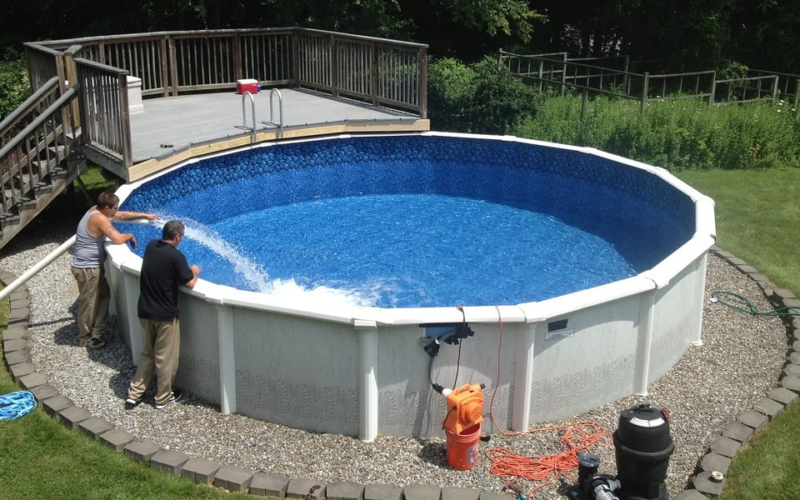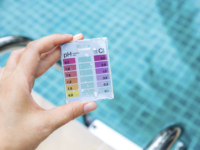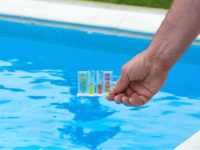Are you considering buying a pool? The first thing to decide is the type of pool, aboveground or inground. The first one lasts longer, while the second one is easier to maintain. It’s a tough choice! In such a case, you may consider semi-inground pools. It is an intermediate option between aboveground and inground.
In this article, you will learn what semi-inground pools are, their pros and cons, what types exist, how to install them, and what problems can occur during their use.
What Is a Semi-Inground Pool?

A semi-inground pool is one partly buried in the ground and partly above it. Usually, only a few inches are above the ground, but most of the pool is under ground level. Its design can be functional. Thus, you can make a minibar or a waterfall on the edges above the ground.
If we compare semi-inground pools with aboveground and inground ones, they have distinguishing features. For example, most of the pool’s parts are below ground level, so they are made from durable materials like concrete or fiberglass. As for transportability, they, unlike aboveground ones, cannot be folded and moved to another place.
In addition, semi-inground pools have several other pros and cons, which we will describe next.
Pros and Cons of Semi-Inground Pools

Pros
- Delivery. Unlike inground pools, this type comes as a kit. Thus, you do not have to pay for the expensive shipping of a one-piece pool.
- Installation. You do not need to dig a deep pit like for inground pools. Also, it is worth noting that a semi-inground pool’s installation is 16-18 times faster than the inground one (3-5 days versus 8-12 weeks).
- Design. You can embed your semi-inground pool into your environment design in whatever way you like. Thus, it is possible to adjust the height and add any accessories located on the aboveground part.
- Warm water. We know that the water in inground pools is cooler than in others. They are fully surrounded by earth, which cools the pool walls and, accordingly, the water. As for the semi-inground, some part of the pool remains above ground level, so the water temperature is higher. Thus, you use less electricity to heat it.
Cons
- Shape. Usually, you will find only a small selection of semi-inground pool shapes: round, square, or rectangular.
What Are the Types of Semi-Inground Pools?
Manufacturers make semi-inground pools using almost the same materials as inground pools. Therefore, you will find three main types: vinyl, concrete, and fiberglass.
Next, we will describe the advantages and disadvantages of each type so that you can compare and choose the most suitable option.
Vinyl Liner

Vinyl pools consist of panels (plastic or metal), a layer of sand or cement, and a vinyl liner. These pools have the following advantages and disadvantages:
Pros
- Surface. The vinyl finish is very smooth. Therefore, you won’t tear or scratch your clothes.
- Design. The pool’s design allows you to select modular walls of different sizes and shapes. Therefore, you can create the design you want.
- Price. The cost of vinyl pools is about one and a half times less than concrete. Thus, if a concrete pool costs $14,000, a vinyl pool of the same size will be about $10,000.
- Maintenance. The pool’s design does not create additional difficulties during maintenance. Thus, you just need to clean/vacuum the surface, measure the levels, and use the appropriate chemicals.
Cons
- Durability. The vinyl liner should be replaced every 10 years. For comparison, concrete pools last ±50 years (5 times more).
Concrete

A concrete pool is created using shotcrete. It is a dry substance mixed with water to spray and shape the walls and floor of the pool. This type has the following advantages and disadvantages:
Pros
- Durability. Concrete is a durable material that does not crumble and is not afraid of scratches. They last about 50 years. This is two to four times longer than vinyl, and almost twice as long as fiberglass.
- Adjustable shape. You can shape the pool shell yourself while spraying the shotcrete. Therefore, you can make a sloping floor, rounded corners, and so on.
- Design. You can make a concrete pool of any color! Firstly, the material comes in different colors: from light beige to blue. Secondly, you can color it yourself. In this way, your pool will perfectly match the design of the environment.
Cons
- Installation rate. It takes 3-4 weeks to install a concrete pool. This is almost double as long as the time required for vinyl ones.
Fiberglass

A fiberglass pool has a one-piece shell, which is manufactured in specialized factories from reinforced fiberglass. Such a pool has the following advantages and disadvantages:
Pros
- Less algae. The surface of fiberglass pools has no pores. Therefore, it is more difficult for algae to cling to walls and multiply. As a result, you can use fewer chemicals to eliminate the algae.
- Price. Fiberglass pools, like vinyl ones, cost almost one and a half times less than concrete ones.
- Fewer chemicals. Because the pool surface is non-porous, you don’t need to wash the walls with chemicals to eliminate debris and bacteria that can accumulate in the pores. Therefore, you can save on chemicals.
Cons
- Deformations. Fiberglass is more susceptible to deformation than concrete. Therefore, when installing, you should use gravel backfill because it does not settle like sand.
How Much Do Semi-Inground Pools Cost?

Semi-inground pools’ price range is highly variable. The cheapest models start at $2,500, while expensive ones can reach $25,000 or more. It is affected by the size and the model’s material. Obviously, the larger the pool, the more expensive it is, and the price of concrete and fiberglass ones will also be higher than that of vinyl.
Depending on the budget, the cost of semi-inground pools fall into the following ranges:
| Low cost | Mid cost | High cost |
| $2,500-7,000 | $11,000-12,000 | up to $25,000 |
Depending on the material, the cost of semi-inground pools are in the following ranges:
| Type | Vinyl | Fiberglass | Concrete |
| Installation Cost | $21 per sq. ft. | $35-66 per sq. ft. | $55-72 per sq. ft. |
| Replacement Cost | $3,000-4,200 | $3,500-10,000 | $2,500 |
Vinyl pools are the cheapest option, as they cost an average of two to three times less than other types. However, from the long-term perspective, you will need to pay two to four times more often and sometimes up to six times more, because the vinyl liner needs to be replaced more often than concrete or fiberglass.
What Are the Cost Differences Between Inground, Aboveground, and Semi-inground Pools?
The cost of inground, semi-inground, and aboveground pools differ dramatically. It is primarily affected by the complexity of the installation and the material of the model. For this reason, inground pools are the most expensive, as they require a long installation period, which takes 16 to 18 times longer than the others, as well as 4 to 10 times more expensive materials.
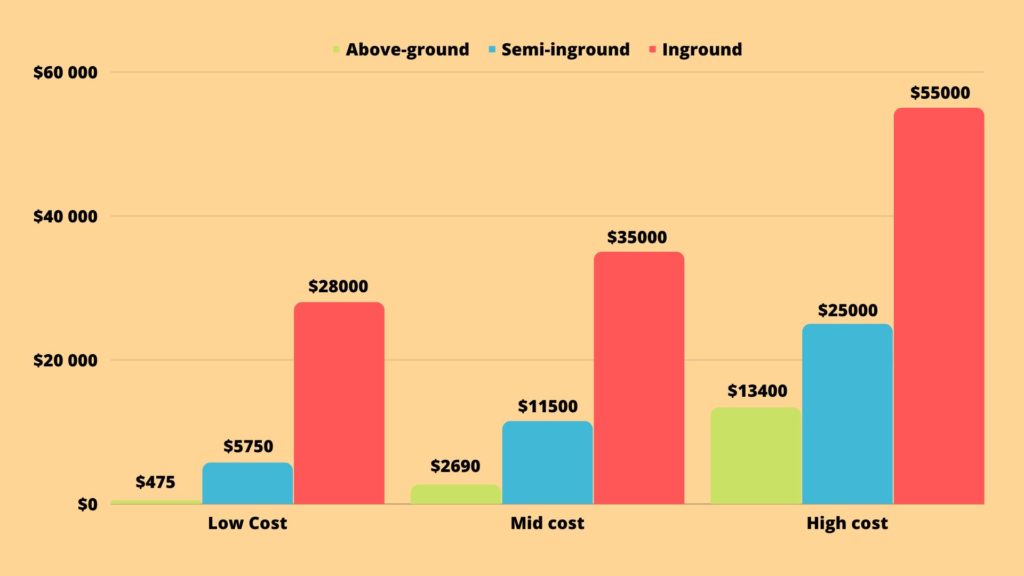
Semi-Inground Pool Installation
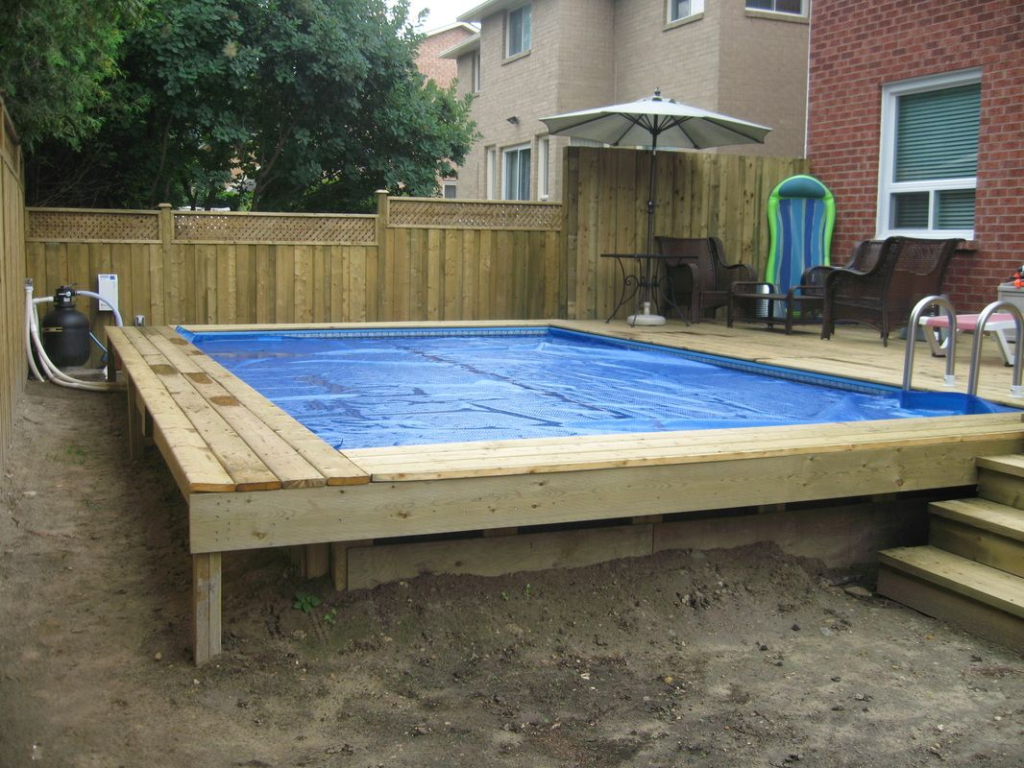
The semi-inground pool installation process is almost the same as the inground one. It is simple, so everyone can carry out this process without installation specialists. It will require the following three steps:
- Pool place preparation. Rent heavy equipment like an excavator to dig a pit of the required size, or call specialists in the excavation of residential buildings.
- Pool installation. You should prepare a form for pouring the pool if you plan to make it concrete. As for the vinyl, it is also worth installing a frame in the pit, on which the walls will be installed later. Fiberglass is the easiest because you can just place the pool shell in the hole.
- Additional equipment installation. You need to install a waterproof membrane with modular panels. Next, assemble the filtration system and arrange the landscape. That’s all!
DIY Semi-Inground Pool

You can install a semi-inground pool yourself, as they come as a kit that contains everything you need:
- Walls
- Top rail
- Sandbar tile liner (if required)
- Skimmer
- Hardware and stakes
- Joint covers
However, you will need to rent heavy equipment like an excavator to dig the pit if you don’t have your own. In that case, expect an additional $1,000-1,500.
Are There Any Problems with Semi-Inground Pools?

Semi-inground pools have two design issues. If you are aware of this and keep an eye on these aspects, your user experience will not be spoiled! These include:
- Wall maintenance. Walls are the basis of semi-inground pools. You need to pay attention to caring for them to avoid the need of replacing them. It can cost $2,500-10,000 depending on the material. In this case, you need to make sure there are no leaks, and regularly clean the walls of algae.
- Water temperature. We previously mentioned that the water temperature in semi-inground pools is higher than inground ones. The structure is not completely in the ground, which cools the walls and the water. Therefore, in warm climates, you may need to cool the water.
Summary: Are Semi-Inground Pools Worth it?
Semi-inground pools are a middle option between inground and aboveground ones. This type is ideal if you have uneven terrain or want to create a custom environment design.
However, in other cases it can also be a great solution, as it combines the benefits of both inground and aboveground. The main thing to keep in mind is to monitor the walls’ condition and regulate the water temperature (if needed).
FAQ
❄️ How do you winterize a semi-inground pool?
You do not have to drain the water from a semi-inground pool during the winter. To winterize, you should follow these steps:
❓ Can semi-inground pools be backfilled?
Yes, because the walls of semi-inground pools are made of durable materials that can withstand the pressure of the earth.
🕘 How long does a semi-inground pool last?
Semi-inground pools have an average lifespan of 10-20 years, roughly one and a half times longer than aboveground ones.
🤔 How deep can semi-inground pools be?
You can find semi-inground pools with depths ranging from 36″ to 8’ from shallow to deep end respectively.
